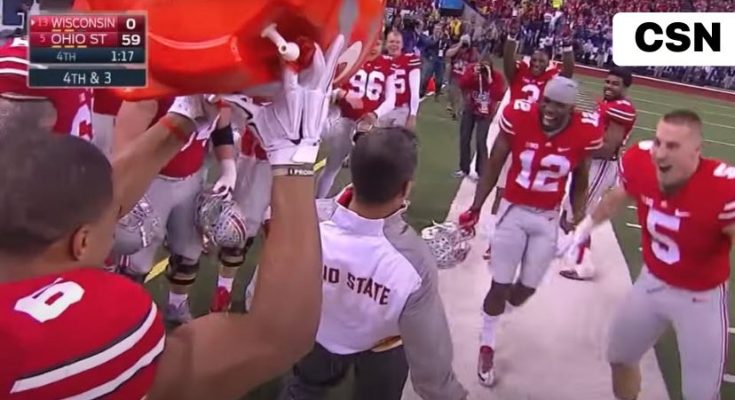It was the night that changed everything for Ohio State football — a game few outside of Columbus saw coming, and one that would be etched in the history of college football forever. When Cardale Jones took the field for his first career start in the 2014 Big Ten Championship Game against Wisconsin, expectations were modest at best. The Buckeyes were on their third-string quarterback, facing one of the nation’s most formidable defenses, and fighting for their playoff lives. Yet what unfolded inside Lucas Oil Stadium was not just a victory — it was a 59-0 demolition, a statement so loud it echoed all the way to the first-ever College Football Playoff, where Ohio State would go on to claim the national championship.
Cardale Jones wasn’t supposed to be the story. He was the next man up after two devastating injuries. First came Braxton Miller’s shoulder injury before the season even began, followed by J.T. Barrett’s heartbreaking broken ankle in the regular-season finale against Michigan. Barrett had been sensational as a redshirt freshman, guiding the Buckeyes to an 11-1 record and keeping playoff hopes alive. But when he went down, many assumed Ohio State’s dream season had gone down with him. The thought of a third-stringer stepping in for the conference title seemed almost laughable. Yet head coach Urban Meyer refused to flinch. He turned to Jones — a big, strong-armed sophomore from Cleveland who had thrown a mere 17 career passes — and told him to be ready for his moment.
That moment came under the brightest of lights. Wisconsin entered the Big Ten Championship ranked No. 13, led by Heisman finalist Melvin Gordon and one of the stingiest defenses in college football. The Badgers’ defense had been suffocating opponents, holding them to under 260 yards per game. Analysts predicted a low-scoring grind, maybe a 20-13 type of affair. But what they got instead was an offensive explosion the likes of which few had ever witnessed on that stage. From the first drive, it was clear Jones wasn’t there to just manage the game — he was there to dominate it.
On his very first drive, Jones made his intentions known. With the poise of a veteran and the arm strength that could make NFL scouts drool, he connected with Devin Smith on a 39-yard touchdown bomb that set the tone. It was a throw that sliced through the dome air and announced to everyone watching that this “third-string” quarterback was anything but ordinary. Moments later, he did it again — another deep strike to Smith, this time for 44 yards. The crowd, initially unsure of what to expect, erupted into disbelief. Ohio State wasn’t just winning. They were obliterating Wisconsin in every facet of the game.
Jones finished the night completing 12 of 17 passes for 257 yards and three touchdowns, each of them a dagger to Wisconsin’s confidence. His performance wasn’t just statistically impressive; it was emotionally seismic. It galvanized a team that had been written off and infused it with a level of belief that would carry them through the next month and into immortality.
Running back Ezekiel Elliott was equally unstoppable, rushing for 220 yards and two touchdowns, slicing through Wisconsin’s defense with breathtaking bursts of speed and power. Every carry seemed to break a tackle or rip off another big gain. The offensive line, maligned earlier in the season, played the game of its life, creating massive holes and giving Jones time to unleash his cannon arm. Wide receiver Devin Smith turned every catch into a highlight reel, while the defense — led by Joey Bosa, Darron Lee, and Vonn Bell — smothered Wisconsin’s attack completely. Melvin Gordon, the nation’s leading rusher, managed just 76 yards. Quarterback Joel Stave never had a chance. The Badgers were overwhelmed from start to finish.
By halftime, the score was 38-0. By the fourth quarter, it was clear something historic was happening. Ohio State wasn’t just beating Wisconsin — they were dismantling them. The final whistle sounded with the scoreboard reading 59-0, the largest margin of victory ever in a Big Ten Championship Game. It was the kind of performance that demanded attention. And the College Football Playoff committee, which had been skeptical of Ohio State’s quarterback situation, couldn’t ignore it. That night, the Buckeyes didn’t just win the Big Ten title — they punched their ticket to the first-ever College Football Playoff.
What followed was one of the most remarkable postseason runs in college football history. Ohio State, seeded fourth, faced top-ranked Alabama in the Sugar Bowl semifinal. Once again, the Buckeyes were underdogs. Once again, Cardale Jones delivered. He threw for 243 yards and a touchdown, while Ezekiel Elliott ran for 230 yards, including an unforgettable 85-yard dagger in the final minutes to seal the 42-35 victory. The nation, watching in awe, realized this wasn’t a fluke. Ohio State had found lightning in a bottle, and Jones was the spark.
Two weeks later, in the national championship game against Oregon, the legend grew. Jones, calm and confident, led the Buckeyes to a 42-20 victory to capture the school’s eighth national title. He threw for 242 yards, ran for another score, and commanded the offense like he had been the starter all season. From third-string to national champion in just three games — it was one of the most improbable and inspiring stories college football had ever seen.
But it all began on that cold December night in Indianapolis. That 59-0 masterpiece wasn’t just a win. It was a cultural moment — a declaration of resilience, preparation, and belief. Urban Meyer had always preached the “next man up” philosophy, but Jones made it real. His performance showed the power of staying ready, of believing in yourself even when the world doubts you. He proved that greatness doesn’t always announce itself in advance — sometimes it bursts onto the scene when you least expect it.
For Ohio State fans, that night remains one of the sweetest memories in program history. It represented redemption after heartbreak, unity after doubt, and excellence under pressure. Players like Elliott, Smith, and Bosa became legends, but Jones was the heart of the story — the unlikely hero who took the biggest stage and owned it.
Even years later, when fans talk about the greatest moments in Ohio State football history, that 59-0 victory always comes up. Not just because of the score, but because of what it symbolized. It was the ultimate underdog triumph — a night when a player with one career start outplayed everyone, when a team found its soul, and when the Buckeyes announced to the world that no adversity could stop them.
Cardale Jones’ story remains a testament to preparation meeting opportunity. He wasn’t supposed to be the hero. But when his number was called, he was ready. In a sport defined by pressure, he delivered perfection. That game against Wisconsin was more than a blowout — it was a transformation. It changed the trajectory of Ohio State football, revived its national dominance, and gave birth to one of the most memorable championship runs the sport has ever seen.
From an untested backup to a national champion, Jones’ journey embodied everything fans love about college football — heart, grit, and the magic of the unexpected. The 59-0 victory wasn’t just a scoreline; it was a symbol of destiny. It reminded everyone watching that in football, as in life, sometimes all it takes is one opportunity — and the courage to seize it.



